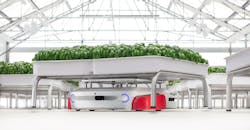Climate change and global warming have become huge topics of interest in recent years. However, what most people do not realize is that industrialized food production has long been one of the largest contributors.
As a population, there needs to be a focus on moving food production away from being one of the leading contributors to being carbon neutral or even carbon negative, Iron Ox CEO Brandon Alexander tells IndustryWeek. “While renewable energy has gained momentum over the past 20 years, food has gone in the opposite direction as we've boosted industrial farming. We put more chemicals into the land, and we've been increasing our greenhouse gas emissions over time.”
According to Alexander, the challenge is in taking a trend that is going in the wrong direction, and shifting it, flatten it out and eventually reversing that curve. Alexander’s firm has taken a tech-centric approach to addressing farming issues. In parallel to the innovations John Deere and Monarch Tractor have introduced, Iron Ox is embracing the latest advances in robotics, autonomy and AI to make a meaningful difference to one of the oldest and arguably most important market sectors in existence.
“Our goal is to get farming to the point of zero waste, where every joule of energy, or every liter of water creates a calorie and nutritional value,” he says. “This is challenging because as a society our understanding of plants today is still fairly rudimentary. Plants are complex, living things tons of variables. If we're going to get to zero waste growing, we need to understand the plant at a level that really isn't possible today.”The Iron Ox solution
Iron Ox has developed its own approach to hydroponics, including a robotics-manned scanning booth. “Every pallet of plants goes through our photo booth and gets scanned multiple times throughout the growth process, which provides us with in-depth 3D images from seed through to adult,” he says. “This information is then embedded to our AI system, and in conjunction with our plant science team, we can constantly look at all the different attributes, color, volume, height, etc. to quickly identify if we have a healthy plant or an anomaly.”
The Iron Ox system is designed to provide the level of granularity its automation requires. “For example, our system may say this plant has a deficiency, prompting our dosing system to give the plant the exact amount of nitrogen it needs rather than the industrialized approach of spraying the whole facility," he says. "With a better understanding of what the plant is doing, we can create a positive change."
This is where robotics enter the picture as well. While the AI system performs critical data learning, the autonomous mobile robot and its robotic arm are constantly listening – and taking action, constantly navigating and serving as the workhorses of the farm including doing any physical action needed to optimize growth cycle operations.
Of course, no matter how much technology you throw at the problem, plant science is going to be key moving forward. “We need to constantly learn and try out new things to really optimize at the plant level. And then continue to do that at scale, and not just for lettuce or strawberries -- there's a lot of crops, and a lot of regions we need to be able to serve,” says Alexander.
By using six-by-six-foot pallet or batches, each pallet can quickly transition from leafy greens to strawberries or tomatoes. Being able to make quick changes required developing a mobile robotic system to constantly monitor the farm determining which pallets needs each specific operation.
The grow system essentially has self-driving car technology with multiple LIDAR systems, upwards and forward-facing camera systems, and a rocker suspension to handle the different variation and the ground as well as strength since pallets weigh over 1000 pounds. “When Grover (how Iron Ox affectionately refers to its autonomous robot) picks up a pallet, it needs to bring it to the correct station without sloshing water. Getting this right took fluid dynamics to make sure our control and acceleration parameters weren't going to spill anything.”
Move towards decentralized farming
Why move to decentralized farms? Simply put, upwards of 90% of the domestically grown produce still comes from California and parts of Arizona. “Couple that with all the trends with extreme drought, it is clear something drastic has to happen. I don't think Salinas Valley is going to be the same 15 years from now," says Alexander. "But with greenhouses and controlled environments, we can set up smaller farms near consumption points. It is important to be able to grow exceptional produce anywhere in the world. With a closed loop AI system we can make sure every single week, at every single location you are getting the most tasty, nutritious, and sustainable produce possible,” says Alexander.
What's interesting about hydroponics is that it is just water and nutrients mimicking conditions of environments like Napa Valley or Salinas Valley to deliver peak growth conditions. "There are very few inherent limitations in the process of hydroponics,” he says. “Where we've seen the limitations come are more machinery or automation based with designs around very specific product. We designed the Iron Ox system to be flexible enough to grow lots of different types of plants all within the same facility. “We want our system to adapt to the plant as opposed to the plant adapted to our system.”
While Alexander has lofty goals, he is under no illusion about the size of the challenge his crew is facing. After all, a move towards the sustainable, decentralized farm model is not going to happen overnight. And, building the next generation of farming will require lots of different backgrounds coming together to make it happen. “We have an amazing plant science team constantly working with our engineering team to help understand what traits we care about, what should we be looking for and what are the actions our equipment should take,” he says. “Indoor, decentralized farming is important. The ability to use dramatically less water with hydroponics also provides critical benefits. While these are all necessary steps, they are pieces to a bigger picture of better plant management.”
About the Author
Peter Fretty
Technology Editor
As a highly experienced journalist, Peter Fretty regularly covers advances in manufacturing, information technology, and software. He has written thousands of feature articles, cover stories, and white papers for an assortment of trade journals, business publications, and consumer magazines.

